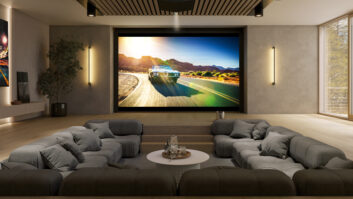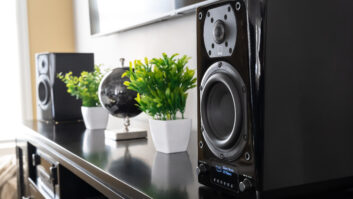The loudspeaker has a greater affect on the sound we hear than anything else in the audio reproduction chain, but as the room stands between listener and loudspeaker, it runs a close second for its impact on what we hear.
Much of what has been written about classical acoustics in textbooks has focused on large acoustical spaces such as concert halls, cathedrals, and auditoriums. Much smaller rooms that typify a home theater or multi-purpose listening room in a residential setting have not received nearly as much attention as those larger spaces, but we know that we cant apply the same large-room design rules and methodologies to these smaller spaces. In some cases, we even need new or different measurements. Often, these are measurements we dont have yet.
Just what is a small room? To an acoustician, its pretty much anything smaller than a concert hall. Richard Rives Bird, president of audio consultancy Rives Audio says that he has generally defined it as covering rooms of less than about 8,000 cubic feet, but that its a gray area. The issues start to change, at some point, as the room volume changes, he explained. The issues of large-room acoustics and small-room acoustics are almost inverted. In large-room acoustics, you are very worried about reverberation times, while in small room acoustics they are an issue, but usually much easier to control.
Harman International Industries vice president of acoustical engineering, Floyd Toole, PhD, frequently lectures at CEDIA EXPO and other industry conferences about loudspeaker-room interactions. Toole has identified certain frequency ranges where either the room or the loudspeaker has the dominant role in what listeners hear. At frequencies below a few hundred Hertz, Toole noted, it is the room that is dominant. Above about 2 kHz, it is the loudspeaker that is dominant. In between is a transition region where the dominant role gradually shifts from one to the other.
Low frequencies are of the biggest issues to get right in small room acoustics. At low frequencies, standing waves (also known as room modes) can interfere with the frequency response of even the best loudspeaker. Standing waves are created as sound waves reflect between opposite parallel walls, or between the floor and ceiling. A standing wave occurs when the distance between two parallel room surfaces is one-half of the wavelength. The reflections that are at the root of the room mode/standing wave problem can create drastic variations in bass levels at different locations throughout the room. This is because at certain points the reflected wave will be in phase with the sound source, adding several decibels to the sound level at that frequency and at that point in the room. At the same time, at another point in the room, the two wavefronts will be out of phase with each other, creating either a complete cancellation (a null point), or something close to it. Complete cancellation would require that the room surfaces be perfect reflectorsnot possible in the real worldbut nevertheless, sharp dips of 20dB or more can easily occur.
One way to remove some of the nastiness at low frequencies is to avoid square or cube-shaped rooms, instead choosing dimensions that are staggered (not integral multiples of each other). This does nothing to eliminate standing waves but does prevent room modes on one axis from occurring at the same frequencies as those on one or more of the other axes.
What to do to reduce these bass-range variations? Equalization doesnt work for several reasons. Itll reduce the level of the peaks, but does nothing for the nulls and can take a lot of power. A 10-dB boost requires 10 times the power within the frequency band thats being boosted. Is your amplifier up to that? Is your speaker? Another problem with equalization is what to equalize for, given that the bass is different everywhere. You can equalize for reasonably flat response at one golden seat, but that comes at the expense of making it sound far worse at most of the other seats.
More effective is the choice of room dimensions. While this wont eliminate standing waves, it will help avoid them reinforcing each other, which works toward reducing the seat-to-seat variations in the bass range. This might not work, however with a pre-existing room.
Reducing reflections gets to the root of the problem, but it isnt easy to absorb low frequencies. A variety of commercial bass traps are available, including absorptive, Helmholtz resonators, and diaphragmatic. The diaphragm absorbers seem to offer the best chance of getting a good combination of high absorption, being fairly broadband operational, and working to fairly low frequencies. Youll likely need a lot of trapping to get the best absorption.
Multiple subwoofers have been shown by Harman International research to dramatically reduce the severity of low-frequency standing waves. The recommended four subwoofers, each located at the midpoint of a wall, works to minimize seat-to-seat variations. You wont necessarily get flat bass response, but at least its consistent seat to seat. You can then use equalization to flatten the spatial-average response.
One area where small rooms differ from their larger brethren is in reverberation. In large spaces without acoustical absorbency, the reflected sounds will bounce around for a long time. This reflected sound field quickly reaches a diffuse (randomized) state, and, in theory, will present a uniform sound level throughout the room without a dominant directionality. (Reflections arrive from many different directions, with no statistical probability favoring any one direction). This diffuse, reflected sound field is called the reverberant field.
Just how reverberant a particular room may be is quantified in terms of its reverberation time, which is measured by first exciting the roomeither by an impulsive sound, such as a bursting balloon or by the sudden stopping of a signal, such as random noise from a loudspeaker. The length of time it takes for the reverberant sound to decay a given number of decibels is referred to as the reverberation time. The standard is to use 60dB as the decay criterion, and this reverberation time (in seconds or milliseconds) is referred to as the rooms RT60.
John Dahl, senior fellow and director of education for THX, noted that in small rooms, youre always listening to a collection of reflections, rather than a randomized sound field. What this means is we dont have a good definition to measure the decay of reflected energy [in small rooms], he said. We do know that people prefer a shorter energy decay time in small rooms and a longer decay time in larger rooms.
Bird said that the reflection decay times Rives Audio shoots for are longer for stereo than they are for home theaterabout 370 milliseconds or a two-channel listening room, while in a home theater sub-300 ms decay times is the goal. Longer decay time for stereo can benefit from a little added room ambience, while in home theaters most of the ambience is supplied via the surround channels. However, those numbers can change depending on the rooms volume and sound loudness. In a small room where someone likes to listen loud, were going to tighten it up quite a lot, Bird said. Its going to have a shorter reflection decay time than a larger room, and where someone likes to listen at more moderate levels. So, we have to understand our client and their listening habits, in order to [make the best decisions on this].
Adding acoustically absorbent materials at appropriate locations in the room can lower reflection decay times. Dahl recommends that this material needs to be at least one-quarter wavelength in thickness. For example, four inches of fiberglass or more will produce a reasonably broadband absorber. One that is too thin will soak up the high frequencies, but wont be very effective in the midrange, changing the overall timbre.
Absorption isnt the only room treatment tool available. Diffusers, which can spread the reflections around, can help to create the type of sound field that exists in large spaces. Interestingly enough, diffusers can also help make absorbers more effective.
The use of less absorption on the floor for two-channel listening is often needed to create the illusion of a broad soundstage. Adding a thick carpet pad or rug increases its absorption coefficient at lower frequencies. In a home theater, its usually going to be a wall-to-wall carpet, Bird said. In a two-channel room, we frequently have a hard surface in the front-third of the room. Or the entire room might be hardwood, but theres an area rug around the listening area. We focus most of the absorption around the listener.
Rives Audio makes heavy use of diffusion for ceilings, depending on what speakers are being used.
Diffusers can always be hidden behind an acoustically transparent fabric, which will reduce the apparent ceiling height in most cases, but not all. On some designs the firm has built the diffusers into the space between joists and attached the fabric to the bottoms of the joists. The trade-off is in sound isolation, since youre removing the layer of drywall thats normally attached to the bottom of the joists and replacing it with acoustically transparent fabric. You have to be clear on what design criteria are most important for each project.
Early reflections, or sounds from left and right speakers that reflect off of sidewalls before reaching listeners, have been a source of debate among acousticians. You want to do something with that first reflection point, Bird said, but theres a lot of contention about exactly what that should be. Do you absorb it? Diffuse it? Our opinion is, yes. It depends on the room…and what its being used for.
In home theaters you want more focus or energy from the direct sound coming from the speakers. In two-channel situations, were trying to create the illusion of an entire soundstage from just two channels. Its a more daunting goal to deal with a two-channel setup than a home theater. The way that we deal with the first and second reflections is often much different for two-channel listening rooms than it is for home theaters. Home theater is far more forgiving. Oftentimes, people lean towards an acoustical solution thats appropriate for two-channel and expand that into multi-channel.
Last summer, Toole presented a paper to the Audio Engineering Society in which he summarized extensive research he had conducted on acoustics and the audibility of various room effects. He argued that reflections in small rooms are nowhere near the problem that conventional wisdom assigns to them. Above the transition frequency, Toole said, if the room is normally furnished, with carpets and drapes, and chairs and bookcases, youre probably in pretty good shape. You dont have to get terribly paranoid about acoustical treatment of rooms if you start with decent loudspeakers. Humans have an amazing capacity to recognize the excellence of these loudspeakers in a wide range of different rooms.
The modern trend toward extremely spare rooms with lots of glass, hard-surfaced floors and minimal window coverings can produce rooms that are too live for most listeningparticularly for rock music and movie soundtracks. Rooms can also be too dead. Somewhere in the middle is a happy medium. Tooles research indicates that multiple subwoofer placements may well be the most effective way to deal with those pesky low-frequency problems. Within the transition region, you have adjacent boundary problems, Toole said, which means that youre going to have to measure and equalize to fix that, but that solution does work.
A former loudspeaker designer, Alan R. Frank ([email protected]) is a networking consultant and freelance writer.







